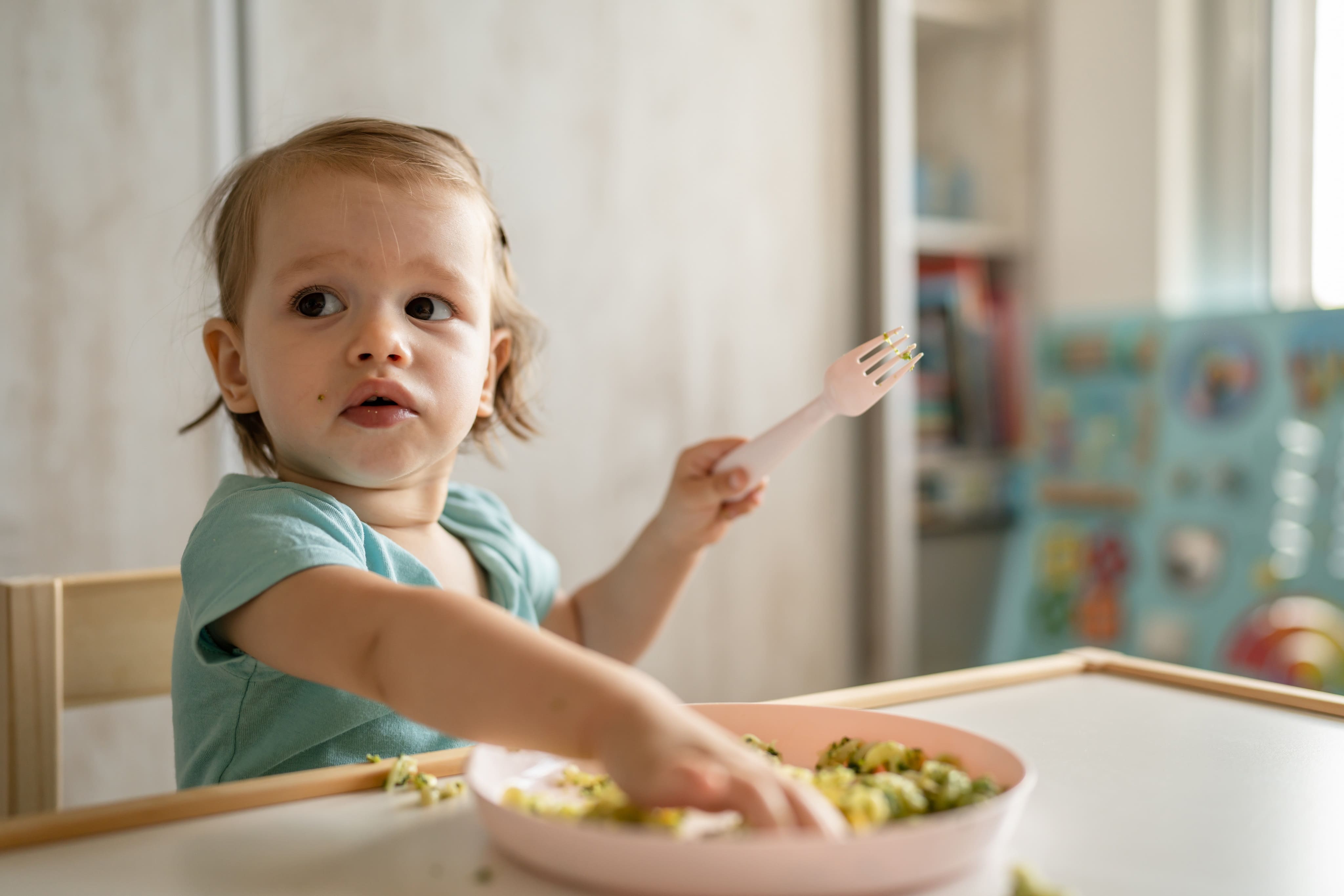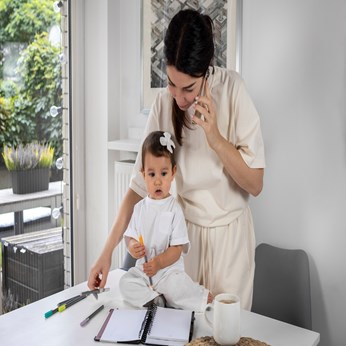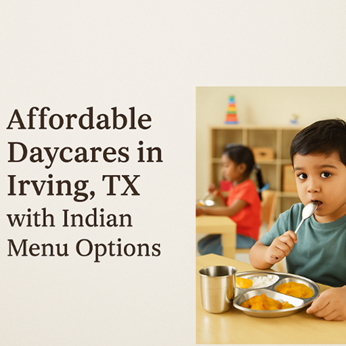Baby-Led Weaning: A Guide for Curious Parents

Baby-Led Weaning: The Better Way of Introducing Your Toddler to New Food
Introducing your baby to solid food for the first time can be quite a milestone both for the baby and for the parent. However, a number of parents in today’s time struggle with it as not much is known about the proper process. Many parents consider it a better decision to intervene in the process and transition from milk to mushy food and then to solids. However, baby-led weaning is a method that has been gaining immense popularity in recent years and is quite appreciated.
What Does Baby-Led Weaning Mean?
Baby-led weaning is essentially when the baby takes the lead in the transitioning period. During this phase, these foods basically complement their primary diet, which is formula or breast milk. The procedure involves putting the baby on a high chair and surrounding them with a variety of finger foods. Through trial and error, the baby learns to take the food from the tray to their mouth all by themselves.
Why Should You Opt For Baby-Led Weaning?
There are many positive effects of baby-led weaning, and this is also why it is gaining traction in the community. Some expected benefits of baby-led weaning include:
- Making eating a rather interactive, positive and independent experience for the baby
- Helping the baby learn what they like and dislike faster
- Encouraging the baby’s coordination and motor skills
- Reducing the time taken to cook the food and feed the baby for parents
When Is Your Baby Ready To Learn?
Before you can indulge in baby-led weaning, you need to understand if your baby is prepared and ready for it. Experts say that most parents rush this process, often ending up with less than desirable results. This is why you shouldgive the baby ample time before involving them in any such process. Usually, the perfect time to introduce baby-led weaning is around 6 months, the time they can sit up.
This is the time when the baby starts showing a profound interest in food. They will be more likely to grab and hold objects and also be able to push foreign objects out of their mouths. This means they will be able to tell the difference between what they like and don’t like, making it easier for them to throw it away.
A Few Good First Foods for Your Baby
It is best if you start the baby-led weaning process with some plant-based foods as they are easy to digest and gut-friendly. You can use:
- Probiotics: Homemade yoghurt
- Vegetables: Steamed beans, broccoli, pumpkin, sweet potato, carrot
- Fruits: Mango, banana, papaya, ripe pear, avocado, ripe peach
However, keep in mind that sugar and salt are a big no-no for the first year. If your child finds the veggies too bland, you can steam them with herbs to add a little flavor. Follow the thumb rule of giving only 1 or 2 new foods every third day. Keep an eye out for allergic reactions. Rest assured, with more new foods, your foodie will soon adapt to the new tastes.
Take the next step toward your goals
Share your requirement and find the best care providers in your area
-
Looking for a caretaker’s job? Build your profile and get in touch with families in your vicinity.
-
Discover nannies, babysitters, cooks, housekeepers, pet sitters, and elder care under one roof.
-
Get all the support you need to run a successful care center.
-
Search for appropriate centers near you depending on your needs.
Care Corner Insights: Blog Library

Overnight Babysitters in Bellevue, WA for Business-Travelling NRI Parents: Safety & Policies
For many NRI parents living in Bellevue, WA, frequent business trips are a reality. While traveling, one of the biggest concerns is ensuring your children are safe, cared for, and emotionally supported during overnight stays. Overnight babysitters ca

Indian Home-Style Cooks in Queens, NY: Tiffin-Style Weekly Meal Prep from Your Kitchen
Queens, NY, is home to one of the most diverse food cultures in the country, and Indian cuisine holds a special place among families looking for authentic, comforting meals. While restaurant takeout is convenient, nothing compares to the taste and nu

Baby Sleep Problems: What is Sleep Regression and How to Handle It
If you’re a parent, you know that baby sleep is one of the greatest mysteries of life. One day your little one is snoozing like an angel, and the next day they’re suddenly waking up every hour, fussing, or refusing to nap. Before you panic, there’s a

What is Validation Therapy? A New Approach to Dementia Care
Caring for loved ones with dementia is one of the most emotionally challenging journeys a family can face. Traditional methods often focus on correcting memory lapses or redirecting confused thoughts—but that can sometimes lead to frustration, stress

What is a Part-Time Nanny and Do You Need One
Parenting is a beautiful journey, but let’s be honest—it can also be exhausting! Between work deadlines, household chores, and family responsibilities, sometimes there just aren’t enough hours in a day. That’s where part-time nannies step in, offerin

Part-Time Housekeeper Hiring in Alpharetta, GA: Weekly Schedules, Pricing, and Must-Do Tasks
Keeping a home spotless while balancing work, family, and personal commitments can be overwhelming. For families and professionals in Alpharetta, GA, hiring a part-time housekeeper is one of the most practical solutions. Whether you need help once a

Affordable Daycares in Irving, TX with Indian Menu Options: Parent Reviews & Enrollment Tips
Finding the right daycare for your little one is never an easy decision—especially if you’re looking for one that fits your budget and offers familiar food options like an Indian-inspired menu. For parents in Irving, TX, the good news is that several

Can Babies Sleep on Their Side? Tips for Safe Baby Sleep
When it comes to newborns, every parent worries about the smallest details—how they sleep, what they wear, even which way they turn their tiny heads. One common question that pops up is: “Can babies sleep on their side?” The short answer? Not recom

8 Benefits of Hiring a House Cleaner for Your Home
Let’s be honest — keeping a home sparkling clean while juggling work, family, and daily life can feel like a full-time job in itself. That’s where professional house cleaners step in, turning the chaos into calm. If you’ve been debating whether to br

How to Care for a Gassy Baby? What’s Normal and what’s not – Expert Advice
If you’re a new parent navigating the world of burps, bubbles, and baby fussiness—welcome to the club! Gas in babies is incredibly common, especially in the first few months. But how do you know what’s normal and when it’s time to call in expert help